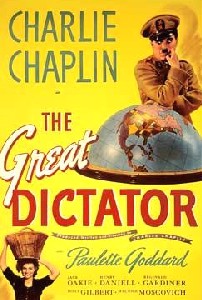
THE GREAT DICTATOR
US, 1941, 120 minutes, Black and White.
Charlie Chaplin, Jack Oakie, Paulette Goddard.
Directed by Charlie Chaplin.
Hitler does not seem to have had a great sense of humour. It would be interesting to know of his reactions to Charlie Chaplin’s satire on him in The Great Dictator. Chaplin made The Great Dictator in 1940, prior to America’s joining in World War Two. He took it as an opportunity, with his Jewish background, to defend the Jews who were being persecuted as well as to offer to the world a criticism of Hitler. He called his film a story of a period between two world wars in which insanity cut loose, liberty took a nosedive and humanity was kicked around somewhat.
Chaplin uses many of his silent techniques and the methods that he had used for many decades. Chaplin had not made a strong transition to the sound era with City Lights and Modern Times, excellent films, but still employing many of the silent traditions.
Chaplin also capitalises on his little man image in the presentation of the everyman figure, the barber. This contrast with his characterisation of the Hitler character, Adenoid Hynkel. It is ironic that both Hitler and Chaplin had the same kind of moustache – which meant then that Hitler was an obvious target for Chaplin.
Jack Oakie appears in a satire on Mussolini.
The film is a blend of the serious and the comic – with more impact in its time when it was so relevant than in later decades. However, it stands out as a piece of social and political satire, indicating how cinema can be relevant in its critique of the contemporary times. It also paved the way for other satires on Hitler and the Third Reich including Ernst Lubitsch’s To Be Or Not To Be which came out in the following year (and was remade in the 1980s by Mel Brooks). With Mel Brooks, of course, it led to the film version of The Producers as well as Brooks’s adaptation of it for a musical on Broadway as well as a film.
Paulette Goddard appears in the supporting cast as the leading lady. She had appeared in Chaplin’s Modern Times and he had married her.
1. The film in Chaplin's canon? It qualities for Chaplin's performances, techniques, comedy and irony? Chaplin taking the contemporary themes of fascism? The importance of the sub-title "This is the story of a period between two world wars - an interim in which insanity cut loose, liberty took a nose-dive and humanity was kicked around somewhat".
2. Chaplin's use of silent techniques and the long tradition he had in this kind of film making? How well had he adapted to sound techniques by 1940? The importance of the dialogue and yet also of captions? His reliance on the orchestration of his musical score?
3. The focus of the title and its emphasis on fascism, reference to Hitler and Mussolini? The reaction to fascism and dictatorship on Chaplin's part? His contrast of the dictator with the ordinary citizen?
4. Chaplin's skill in presenting the two characters? The identification of his old Tramp image with the humanised figure of the Barber? The contrast with Adenoid Hynkel? His making his comic skills serve a particular social and global purpose in the late thirties and early forties? The impact of this moralising comedy now?
5. The portrait of the barber? Involvement in World War 1, his role when the pilot was shot, flying upside down, losing his memory? Hospitalisation? The home background of the barber and the ordinary town life, the village atmosphere, his relationship with his neighbours? The importance of the relationship with Harmah and her qualities? His Jewish background and its importance for this plot? His losing his memory? The barber as the ordinary man persecuted in the thirties?
6. The portrait of the people in the village, their way of life, people who were to be victimised, especially Hannah?
7. Chaplin's observation and comment on Europe in the thirties and the role of the dictators and their effect on ordinary people? How much truth was told in the indirect and ironic comment of comedy?
8. Chaplin's skill at parodying Hitler as Adenoid Hynkel? The importance of his height, face, the Chaplin moustache made sinister as similar to Hitler's moustache? How well had Chaplin studied Hitler's Great dictator speeches and manners? The parody in the speech sequences, the sequences with his advisers? The parody of Hitler and the satire? The importance of Hitler during comedy routines more suitable to Chaplin's little fellow, for example going up the fire pole, the ballet with the globe etc.?
9. The satirical observation of Hitler's advisers especially in the character of Garbatach?
10. The differing satire on Mussolini with the character of Benzino Napaloni? The effectiveness of having Jack Oakie with his genial American comedy style as Napaloni? The parodying of particular events of the thirties, for example Napaloni's arriving at the station and missing the red carpet? The highlighting of the rivalry between the two especially with the barber's chairs going higher and higher? The deeper satire in presenting the cynical agreements of the two agreeing to invade Austerlich?
11. The visualising of war - the memories of World War I, Hitler's taking over of countries in the late thirties, the beginnings of World War II? Impact now?
12. Using the technique of mistaken identities for highlighting the clash between the barber and Hynkel? The transferring of each to the other's world and the repercussions?
13. The importance of the barber's speech and its antiwar tone? How well did Chaplin compose this speech, his ideas, sentiments, observations on war and dictatorship? An important moralising speech for the times, its impact now?
14. How well did Chaplin combine humanity, sentiment, comedy and satire?